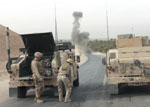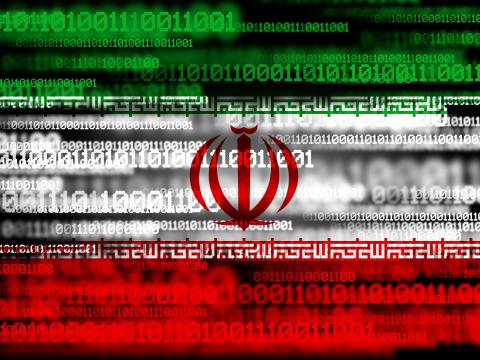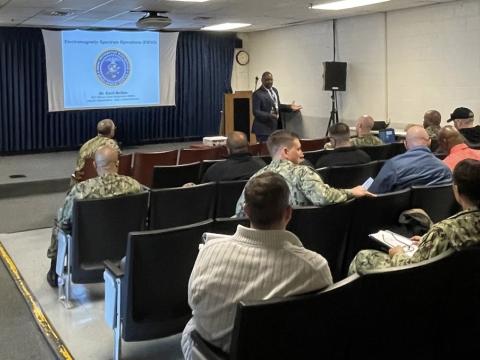Organization Targets Bandwidth Battles
 |
| Members of a joint U.S. Navy and Marine Corps explosive ordnance disposal team destroy an improvised explosive device near Forward Operating Base Hit in Iraq. The countermeasure devices the military deploys are radio frequency based and can cause unwanted interference with other systems. |
Invisible conflicts are erupting on the battlefield as
Last spring, the Defense Department’s chief information officer, John G. Grimes, directed the Defense Information Systems Agency (DISA),
The need for spectrum has been growing exponentially, Atkins says. Communication systems require space on the spectrum, as do munitions, weapons systems, logistics, radars, sensors, navigation systems and numerous other devices. In addition, it is the foundation for the wireless Global Information Grid, an essential element in enabling enterprise services to the edge, she states.
Electromagnetic-spectrum-dependent resources play an integral part in future concepts as well, and spectrum management processes must change to support them, Atkins adds. “Too often, the Defense Department has been perceived as really slow to catch on to the importance of evolving spectrum management techniques, capabilities, solutions and philosophies. That’s all changing. Part of that change was the relatively recent creation of the DSO. It signals the department’s serious intent to be a national, global and proactive leader in spectrum policy and use,” she maintains.
As a center of excellence, the DSO is the largest element of spectrum engineering expertise in the Defense Department. It supports not only the military departments but also the Joint Staff, the combatant commands and the Office of the Secretary of Defense. For the first time within the Defense Department, a single organization can address all facets of defense spectrum management in multiple areas, including policy development, strategic planning, technology, analysis, acquisition and operations. Because these elements are interrelated and interdependent, the right strategies must be developed to produce needed change across processes, people and technology, Atkins says.
And significant change is exactly what is needed to make spectrum management effective in the future, she adds. Currently, spectrum management capabilities still are relatively stovepiped and require a person in the operational loop. This time-consuming method makes it difficult to react to changes in the environment and requires considerable resources, creating problems on the battlefield.
“What we’re trying to do is lay out a road map and a framework that allows us to move from where we currently are into a network-centric environment with standardized data, pushing services and data out to the right folks, right place, right time. Eventually, what we’d like to see is a much more distributed, dynamic, cognitive environment. Some of it will be process-related—regulatory rules, data—but we want to reduce significantly the setup time that’s currently required to do spectrum management operationally,” Atkins relates.
A common operational picture of the spectrum environment may enable a dynamic reallocation of resources and ultimately result in more access to spectrum. In addition, the changes could increase the capacity for communications or perhaps boost capabilities in other spectrum-dependent systems such as radar systems, she adds.
“We have some tools today, but they haven’t kept pace with our operations. Right now, our spectrum information—the databases, the information systems and the modeling and simulation capabilities—aren’t really adequate for the complex, dynamic and congested environments that we’re starting to face now and that we will face in the future, so that inhibits our ability to adequately plan and execute operations,” Atkins explains.
But DISA and the DSO cannot and have not been waiting for total solutions before implementing at least some improvements; they are fielding a few solutions incrementally. For example, while developing a long-term strategy that revolves around the Global Electromagnetic Spectrum Information System (GEMSIS), the DSO and other organizations already have begun a phased deployment of tools that help ensure that warfighters can use improvised explosive device (IED) countermeasures and radio communications simultaneously.
“We’re doing multiple things related to that particular challenge. One of the capabilities that has been fielded as an incremental capability is an upgrade to Spectrum XXI, which is a joint spectrum management tool. It allows for greater de-confliction between the counter-IED systems and our own communications systems to help mitigate unwanted interference between those systems,” Atkins says.
The military also is introducing the Coalition Joint Spectrum Management Planning Tool, or CJSMPT, into the field to address this particular problem. It will enhance de-confliction, increase access across databases and provide additional capabilities that will lead into GEMSIS, a longer term solution.
GEMSIS is a system-of-systems tool that the Defense Department envisions as a way for warfighters to maximize their access to spectrum and, as a result, conduct network-centric operations. A joint program, GEMSIS is an integrated set of solutions that ultimately will work across service and functional lines to support the automated planning and the execution of operations.
“It would be leveraged not only to assign operational frequencies in theater, for instance, but also to help developers in designing their systems to make sure they understand the environment in which those systems will operate and that the systems will operate as intended in that environment. That’s pivotal to our strategy and our future success,” Atkins states. The CJSMPT is scheduled to demonstrate a limited spectrum management capability this summer that will lead to a more robust capability in the GEMSIS program.
The Defense Department also is working aggressively toward spectrum data standardization. The goal is to be able to exchange information about spectrum-related issues in a simple, common and well-understood format. This initiative is in line with the department’s overall data standardization activities that also are key network-centric operations enablers.
Although progress is occurring, much work remains. “I think we always want to be further along than we are. When you look at it in terms of military operations in
 |
| Pfc. Chris Blaney, USA, checks his radio during an air-assault raid on suspected insurgent sanctuaries in Mushada, Iraq. Radio communications are vital to network-centric operations; however, increasing demand for spectrum and certain types of equipment is causing one device to prevent use of another. |
Planning and organization are particularly important when
This kind of organization and planning will help the Defense Department face the issues it has been struggling to reconcile, including rapid changes and new spectrum management techniques, she explains. New wireless technologies, the loss of spectrum to an almost insatiable demand for it by the commercial sector and the complexity of working with other organizations all create new challenges, Atkins adds.
But having multiple customers vying for spectrum also is an indication of success, she points out. “Ultimately, everybody wants the same thing. In the broad context, for instance, one of our challenges is that we’re really competing with commercial interests. But ultimately everybody wants increased access to do what they need to do and to increase the prosperity of the nation, whether that’s economically or by enhancing our national defense and security,” she states.
Internationally, especially in coalition environments, partner nations are in the war together, so they cooperate. “The issue boils down to ensuring that you’ve got the right tools or at least the right interfaces, understanding how you can share data because information sharing is not common today and establishing interim standardization so that the right processes are in place,” Atkins says.
The director explains that industry can help the spectrum management community in several ways. “I sincerely believe we need to increase the cooperative efforts between the [Defense] department and industry in this area in particular. We ultimately have the same challenges and goals. We have to work together to maximize access to the spectrum for all of us while understanding that we have to balance competing interests that are really all essential to our nation, whether that’s economic growth, national security, space, science or research,” she says.
Both government and industry must do their part to ensure that objectives can be met. The Defense Department must conduct due diligence in analysis, testing and coordination when it develops or acquires new spectrum-dependent systems to make certain that systems operate as intended in their electromagnetic environment. “It’s really incumbent upon the government as well as the defense contractors to help make that happen,” Atkins states.
In addition, the department must develop technology partnerships to improve how it leverages commercial technologies. However, in some cases, particularly in the wireless realm, commercial technologies may require some modifications to protect operations.
“WiMAX is a good example. Right now, WiMAX is being developed in different frequency bands, and in some of those bands, we would not be able to utilize that technology because it would interfere with some of our systems. So we want to leverage it, but we have to be careful how we do it. We’re working with industry to understand the ramifications and ensure that we can leverage it to the maximum extent possible,” Atkins explains.
The DSO also will need support from industry in other areas. For example, the Defense Department is interested in taking advantage of commercial innovations to improve spectrum efficiency, agility and sharing. Coexistence is going to be key as the spectrum gets more congested, Atkins says.
In addition, the department must work more closely with other federal agencies and the commercial sector to ensure that its regulatory framework is flexible enough—both nationally and internationally—to accommodate and promote some of the technologies that will be vital to success, Atkins maintains.
“Some of these technologies quite frankly are 180 degrees out of sync with how the spectrum is regulated today. That is a challenge. If we want to take full advantage of them in the future, we have to work that process. I think industry is key in that area, particularly in terms of international influence,” she says. “We need to look at this from a win-win perspective, and trust is really key here. We need to trust one another enough to make it happen, and that’s almost the most pivotal element. We’ve talked about technology, and we’ve talked about process, but unless we have trust, we can’t work out the other [elements] to really get to where we need to be.”
Web Resources
Defense Spectrum Organization: www.disa.mil/dso/index.html




Comments